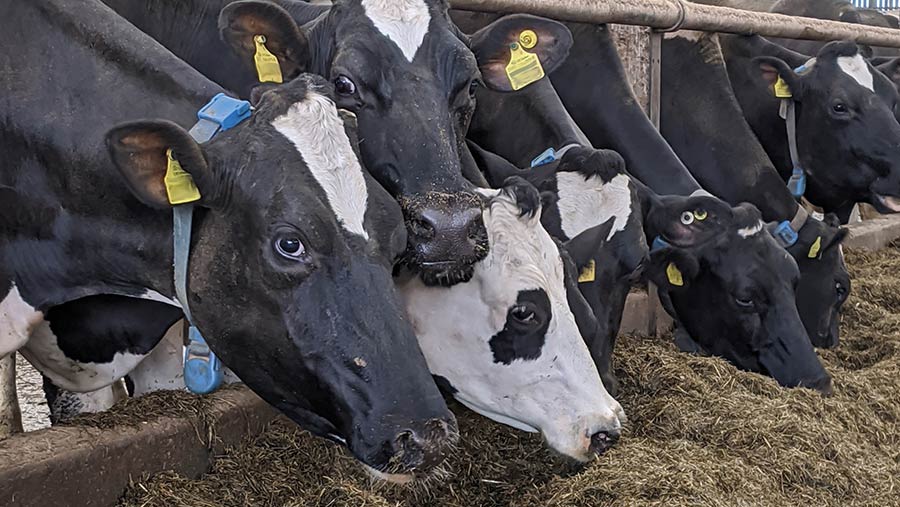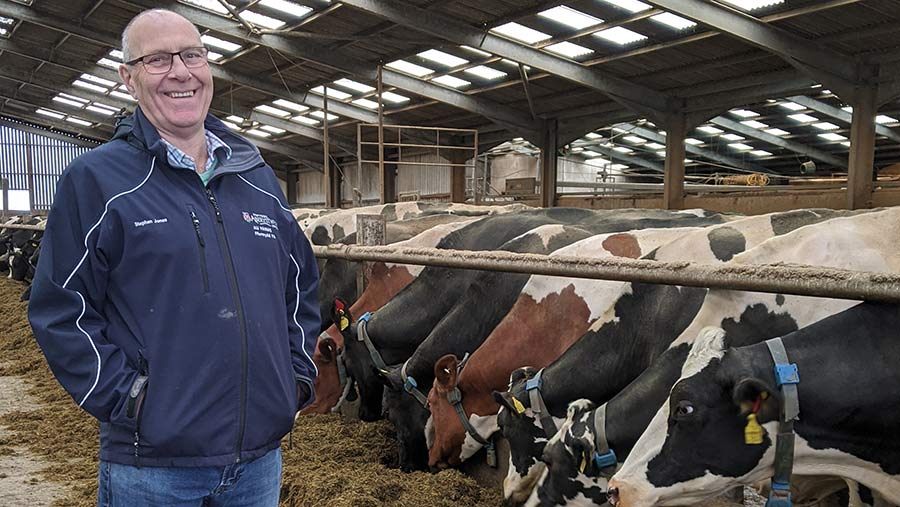How a dairy farm lifted pregnancy to 31.5% through nutrition
 © Stephen Jones
© Stephen Jones Aberystwyth University’s farm manager Stephen Jones has increased pregnancy rates from 20.8% to 31.5% by improving forage quality and dry matter (DM) intakes. At the same time, he has reduced concentrate fed.
When Mr Jones took over running the Trawscoed herd in 2018, the farm’s all-year-round calving 400 Holsteins were facing significant fertility challenges.
Conception rates were as low as 33%, and 40% of culls in July 2018 were due to poor fertility.
See also: 6 ways to improve maiden heifer fertility

Stephen Jones has significantly improved pregnancy rates in two years © Stephen Jones
However, within just two years, Mr Jones has turned things around. He has increased average conception rates to 55% and fertility now only accounts for just 10% of cull cows. Furthermore, calf values have improved by £140 a head.
Farm facts
- Trawscoed Farm
- 400 predominantly Holstein milking cows
- 280-plus Holstein heifers
- 809ha (1,999 acres) in total
- Producing 9,300 litres at 4.22% butterfat and 3.44% protein
- Milking twice daily
- Selling milk to Glanbia
- Growing cereals and pulses for feed, including barley, oats and beans
Nutrition
One of the biggest factors in his success has been changing the herd’s nutrition with the help of independent ruminant nutritionist Hefin Richards.
Poor forage quality was the main limiting factor in the milkers’ total mixed ration (TMR) and he was heavily reliant on using elevated levels of concentrate to close the energy gap.
Grass leys for silage production were very mature and had been managed with little analysis work. Soil tests revealed low pH and nutrient indices. In response, he tailored lime, fertiliser and organic matter applications and reseeded about 50ha (20 acres) with Aber perennial ryegrasses and red clover.
This has improved silage quality. In 2019, first-cut silage from mature leys averaged 10.5-10.8MJ/kg DM, with neutral detergent fibre (NDF) of 45.6% and D value (digestibility) of 67.54%, providing 111.9MJ a head of the 256.7MJ in the milking ration.
In 2020, first-cut samples – which included younger grasses – averaged more than 12MJ/kg DM with NDF at 40% and a D value of 77.53%, providing 132.6MJ a head in the ration.
Crimped grain produced from home-grown barley has been introduced to the TMR, which has allowed Mr Jones to reduce the amount of concentrate fed from 7.25kg a head a day to 3.25kg, contributing a total feed cost saving of 0.5p/litre/day.
“Crimping the grain reduces its impact on rumen pH, lessening the risk of sub-clinical acidosis, which can have a big effect on fertility and the utilisation of nutrients from the diet,” explains Mr Jones.
To further improve rumen health and provide structural fibre, he has added chopped straw to the ration.
These changes have boosted DM intakes from 19.5kg to 21.1kg a head a day, and improved body condition uniformity at drying off.
The target is to dry cows off at a body condition scoring (BCS) of 2.75. “This makes the cow easier to manage through the transition period,” explains Mr Jones. “Negative energy balance is no longer prolonged – cows are ovulating and performing under less feed pressure, and are more receptive at service with sexed semen.”
Ration comparison |
||
|
|
Before |
After |
|
Silage |
28kg (10.36kg DM) |
28kg (10.78kg DM) |
|
Chopped barley straw |
n/a |
0.5kg |
|
Crimped barley |
n/a |
6kg |
|
Water |
6kg |
6kg |
|
Energy blend |
7.25kg |
3.25kg |
|
Protein blend |
2.75kg |
3kg |
|
Megalac |
0.35kg |
0.3kg |
|
Molale |
1kg |
n/a |
|
Dairy minerals |
0.12kg |
0.12kg |
|
Actisaf |
n/a |
0.05kg |
|
Buffer |
n/a |
0.05kg |
|
Biotal digestaid |
0.03kg |
n/a |
Breeding
All breeding is through artificial insemination (AI) and carried out by the farm’s AI technician.
Mr Jones started using sexed semen in 2018 to reduce the number of low-value dairy bull calves.
“We wanted to target heifer replacement breeding and beef on dairy to increase surplus calf value,” he explains.
Trawscoed Farm breeding programme
Cows
- The top 35% of pedigree Holsteins are served using pedigree Holstein sexed semen. Two services to sexed and then to a Fertility-plus Aberdeen Angus
- Remaining cows including crossbreds served using a Fertility-plus Aberdeen Angus
- The 10 pedigree Jerseys are bred pure using the same protocol as the Holstein
- Cows are served at around 50 days post-calving at 2.75 BCS
Heifers
- 90% are served with pedigree Holstein sexed semen
- Served twice to sexed semen, with returns served once to conventional Holstein, and, thereafter, once to conventional beef
- Heifers are first served at 14 months of age weighing about 350-360kg
- All heifers returning at 18 months of age are culled
Using sexed semen to fulfil replacement requirements, he now AIs lower genetic merit cows with a Fertility-plus Aberdeen Angus. This produces a beef calf worth an average of £140 more than dairy-bred calves. “There is about £8 difference between conventional and sexed semen straws. However, that’s trivial when you look at the potential gains per calf.”
And sexed semen success is reflected in the 10% lift in conception rates at first service, with cows averaging 40% (two straws a pregnancy) and heifers averaging 60% (1.5 straws a pregnancy).
Heat detection was originally managed with Moomonitor collars and daily AI technician observations, but cows and heifers were not grouped, making breeding management difficult.
Fresh cows are now grouped up to 150 days post-calving for easier identification and feeding, and then moved to another group. Heifers are grouped separately. “It makes management much easier and less stressful for stock and technician,” he says.
To further improve genetic gain and replacement efficiency, Mr Jones is introducing genomic testing of heifers at birth. “Rearing costs are around £1,900 a head – identifying the best heifers would enable us to tailor calf management and reduce costs,” he explains.
Comparison of fertility trends |
|||
|
Fertility factors |
July 2018 |
July 2019 |
July 2020 |
|
Voluntary waiting period (days) |
60 |
50 |
50 |
|
Average days to first service |
70 |
62 |
62 |
|
Calving Index (days) |
396 |
383 |
375 |
|
Days to pregnant |
120 |
102 |
99 |
|
Cow – conception at first service (%) |
37 |
37 |
42 |
|
Heifer – conception at first service (%) |
88 |
63 |
65 |
|
Age at first calving (months) |
30 |
27 |
24 |
|
Average number of straws a cow a pregnancy |
2.23 |
2.17 |
2.04 |
|
Average number of straws a heifer a pregnancy |
Bull |
2 |
1.48 |
Advice on limiting factors
Nutrition is one of the fundamental components of a healthy, reproductive animal. Hefin Richards of Rumenation Nutrition Consultancy offers his top tips.
Diet formulation and practical feeding
Formulate diets to meet nutritional requirements at different production stages, according to the availability and composition of home-grown and purchased feeds, including mineral and vitamin supplementation.
Often feed is inadequately mixed, refusal allowance is insufficient and cows are selective feeding.
Calibrate feed and mixer wagons and manage feed and drinker space to allow less dominant cows access. Cows should have 10cm of linear drinking space each. Milking cows require at least 50cm of eating space each, with close-up and early lactation cows needing double that.
Monitor rumen fill – standing milking cows two hours after fresh feed should score above three.
Energy
Energy is usually the first limiting factor for fertility. The late lactation period is the best time to control body condition and dry off at 3-3.25 BCS. A lactating Holstein requires around 80-85MJ of metabolisable energy (ME)/day for maintenance, with additional MJ/litre of milk.
Dry cows need careful energy control to avoid metabolic and calving issues. Far-off Holstein dry cows will need 95-100MJ/day while close-up cows will need about 115MJ.
This is usually achieved by feeding less leafy forage and more structural fibre like chopped straw. Have forage analysed to understand energy and protein balance.
Production figures
- 78p/litre margin over purchased feed
- 29p/litre cost of production
- £1,900 rearing cost (calf to calving)
- 30% replacement rate
